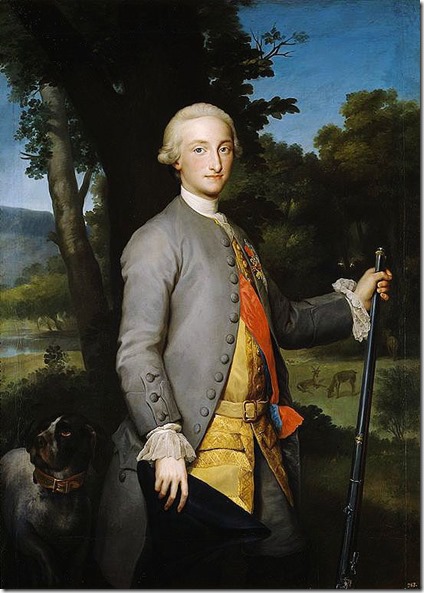The future King Charles IV of Spain was born on 11 November 1748 in Naples, the second son of Charles, King of Naples and Sicily, and Maria Amalia of Saxony. He was christened Carlos (Charles to the Anglophone speakers) Antonio Pascual Francisco Javier Juan Nepomuceno José Januario Serafín Diego, and given the title of the Prince of Taranto.
When little Carlos was almost eleven, his father, the fifth son of Philip V of Spain, inherited the throne of Spain from King Ferdinand VI of Spain, becoming King Charles III. Although Carlos was the second born son, he was the heir apparent to his father’s crown, because his elder brother, Don Felipe, was mentally disabled.
As prince, Carlos was very physically gifted and nicknamed El Cazador(the Hunter), and had a reputation for sweetness and piety, but sadly the young man wasn’t the brightest star in the sky when it came to wits. In a world where kings needed a knife-like edge to keep their thrones, he was spoon. Thus, he was a less than able monarch when he inherited his father’s titles in 1788.
Even though he had a profound belief in the sanctity of his office, and kept up the appearance of an absolute, powerful monarch, Charles never took more than a passive part in his own government. The affairs of government were left to his wife, Maria Luisa, and his prime minister, while he occupied himself with hunting.
All went well for Carlos as long as his wife and cabinet members made good decisions, but in 1792 Manuel de Godoy became prime minister, and reportedly Maria Luisa’s lover as well. With the absolute backing of the queen, Godoy became a de facto king, and he wasn’t a very good one in the long run.
After more than 15 years of Godoy inept rule via paper crown, the populace the began to see deposing Charles III in favor of his eldest son, Crown Prince Ferdinand, the political enemy of Godoy. The supporters of the crown prince, called fernandistas, staged a failed coup in 1807. However, subsequent riots and revolts forced King Charles IV to abdicate in favor of the crown prince on 19 March 1808.
Charles was less than thrilled by the usurpation of his son, Ferdinand VII, and in one of the silliest moves in political history, went to Napoleon Bonaparte for help get his throne back. To no one’s surprise but Charles IV’s, Napoleon forced Ferdinand VII to relinquish the crown, “declared the Bourbon dynasty of Spain deposed, and installed his brother, Joseph Bonaparte, as King Joseph I of Spain.”
Whoops.
Former King Charles, former Queen Maria Luis, and former Prime Minister Godoy were were all taken captive by Napolean, and held in Marseille until the collapse of the Napoleon’s regime. Ferdinand VII was recognized as king of Spain once more on 11 December 1813, leaving his father without a throne and unwelcome in Spain.
Charles and Maria Luis moved into the Palazzo Barberini, in Rome, which is a masterpiece of architecture covered with magnificent works of art, and thus a gorgeous consolation prize for a crown. There the former king and queen lived reasonably quietly until January of 1819, when they died within a few weeks of one another; Maria Luis on the 2nd and Charles on the 20th.



